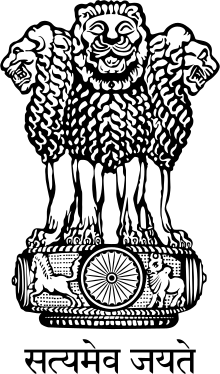Satyameva Jayate
"Satyameva Jayate" (Sanskrit: सत्यमेव जयते, pronounced [s̪ɐt̪jmeːʋɐ ˈd͡ʑɐ.jɐ.t̪eː], IAST: satyam-eva jayate; lit. "Truth alone triumphs") is a part of a mantra from the Hindu scripture Mundaka Upanishad.[1] Following the independence of India, it was adopted as the national motto of India on 26 January 1950, the day India became a republic.[2][3] It is inscribed in the Devanagari script at the base of the Lion Capital of Ashoka and forms an integral part of the Indian national emblem. The emblem and the words "Satyameva Jayate" are inscribed on one side of all Indian currency and national documents.

Origin
The origin of the motto is mantra 3.1.6 from the Mundaka Upanishad. The mantra is as follows:
- In Devanāgarī script
सत्यमेव जयते नानृतं सत्येन पन्था विततो देवयानः ।
येनाक्रमन्त्यृषयो ह्याप्तकामा यत्र तत् सत्यस्य परमं निधानम् ॥[1]
- Transliteration
satyameva jayate nānṛtaṃ
satyena panthā vitato devayānaḥ
yenākramantyṛṣayo hyāptakāmā
yatra tat satyasya paramaṃ nidhānam[4]
- In English
Popular connotations
Popular connotations also include:
- 'Truth stands Invincible'
- 'Truth alone conquers, not falsehood'
- 'The true prevails, not the untrue'[6]
- 'Veritas Vincit', a direct Latin translation.
- 'Truth alone conquers, not untruth'[7]
- 'Truth Alone Triumphs, not (na) that against Sacred law (Rta)
- Vaymaiye Vellum (Tamil: வாய்மையே வெல்லும்)
- Satyakke Matra Vijaya (Kannada: ಸತ್ಯಕ್ಕೆ ಮಾತ್ರ ವಿಜಯ)
The slogan was popularised and brought into the national lexicon by Pandit Madan Mohan Malaviya in 1918 when serving his second of four terms as President of the Indian National Congress.[8]
See also
- List of Indian state mottos, for mottos adopted by individual states of India
- Truth prevails, the national motto of Czech Republic that has the same meaning
References
- "Mundaka Upanishad". IIT Kanpur. Retrieved 4 June 2020.
- "Motto for State Emblem" (PDF). Press Information Bureau of India - Archive.
- Department related parliamentary standing committee on home affairs (25 August 2005). "One hundred and sixteenth report on the state emblem of India (Prohibition of improper use) Bill, 2004". New Delhi: Rajya Sabha Secretariat, New Delhi: 6.11.1. Retrieved 26 September 2008. Cite journal requires
|journal=(help) - "The Mundaka Upanishad with Shankara's Commentary". Wisdom Library.
- Swami Krishnananda. "The Mundaka Upanishad:Third Mundaka, First Khanda".
- (Max Muller (SBE 15))
- (Radhakrishnan, The Principal Upanishads) - citations from Mehendale
- "Minutes of the first meeting of the National Committee for Commemoration of 150th Birth Anniversary of Mahamana Pandit Madan Mohan Malaviya 26 July 2011 at 6.00 pm - 7, Race Course Road, New Delhi" (PDF).